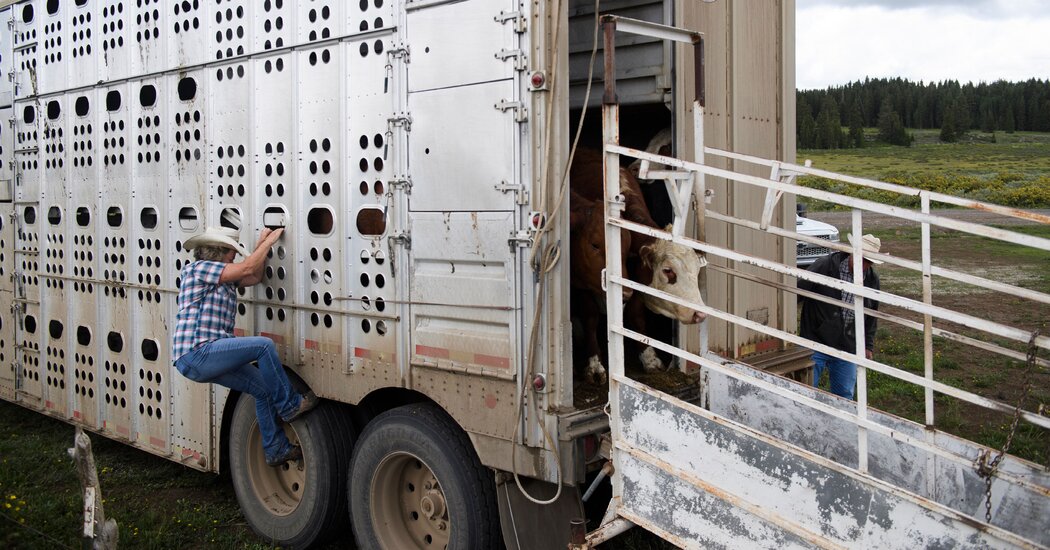
The Biden administration on Wednesday said that it would begin requiring dairy cows moving across state lines to be tested for bird flu, which has been spreading in herds for months. The new policy is part of a growing effort to stamp out the spread of a virus that federal health officials have sought to reassure Americans poses little risk to people so far.
The new order, issued by the Department of Agriculture, says that lactating cows must test negative for influenza A viruses, a class that includes bird flu, before they are transported. The owners of herds with positive tests will need to provide data on the movements of the cattle to help investigators trace the disease.
The testing will help protect the livestock industry, limit the spread of the virus and “better understand this disease,” Mike Watson, a senior Department of Agriculture official, told reporters in a press briefing Wednesday morning.
Since a highly contagious form of bird flu was detected in the United States in 2022, federal officials have sought to reassure Americans that the threat to the public remained low, even as the virus infected a growing number of mammals. Federal regulators on Tuesday announced that inactive viral fragments had been found in pasteurized milk, a suggestion that the virus was likely spreading much more widely among cattle than previously known.
Dr. Nirav Shah, the principal deputy director of the Centers for Disease Control and Prevention, told reporters on Wednesday that there were no changes in the genetic makeup of the virus that would allow it to spread easily among people. So far, Dr. Shah said, states have been monitoring 44 people who were exposed to the virus and are being monitored for infection.
As of Wednesday, the outbreak had spread to 33 herds in eight states, according to the U.S.D.A. But just one human infection has been reported, in a dairy worker in Texas who had direct contact with sick cows. The case was mild.
The U.S.D.A. order came after public health experts and dairy producers had criticized the Biden administration for the scope of its investigation into the cow outbreak and the lack of widespread testing. Some states have moved on their own to bar dairy cows coming from states that have recorded infections, fearing that the virus could spread further.
The order will also require laboratories and state veterinarians to report any positive tests from cattle to the U.S.D.A. Mr. Watson said that the department would be able to conduct tens of thousands of tests each day, with results reported after one to three days. The agency will now reimburse dairies for testing cows without symptoms as well as those being moved.
It is still not clear when the bird flu outbreak began, but farmers in the Texas panhandle have been reporting sick cows since at least February. Wild birds, which carry the virus, could have passed the pathogen to cows by contaminating their water sources or feed.
Cows were not typically thought to be susceptible to bird flu, and it was not until late March that federal officials announced that the virus had been detected in sick cows in Texas and Kansas.
A new analysis of genetic data suggests that the outbreak may have begun as early as December. The virus then spread from cow to cow, and from one state to another as cows moved across the country.
Mr. Watson, the U.S.D.A. official, said that a number of factors motivated federal officials to institute the new rule on interstate movement. The virus was spreading between cows in the same herd, and from cows to poultry, he noted. It was also spreading between dairies linked to transported cows, and among asymptomatic cows that had tested positive for the virus.
So far among cattle, the virus seems only to affect lactating cows, and only temporarily. But federal scientists are still working to understand how the virus is spreading. High levels of virus in milk samples but relatively low levels in nasal swabs suggest that the virus might be spreading in milking parlors.
Federal officials have struggled in some instances to gain the kind of access they have sought from farms that might have infected cows and workers. Dr. Shah, the C.D.C. official, said that the federal government was relying on local health officials and health workers to communicate with dairy producers and their workers, including veterinarians who have close relationships with people who might be hesitant to open up to strangers.
“There may be owners that are reluctant to work with public health, to say nothing of individual workers who may be reluctant to sit down with somebody who identifies themselves as being from the government in some way,” Dr. Shah said.

